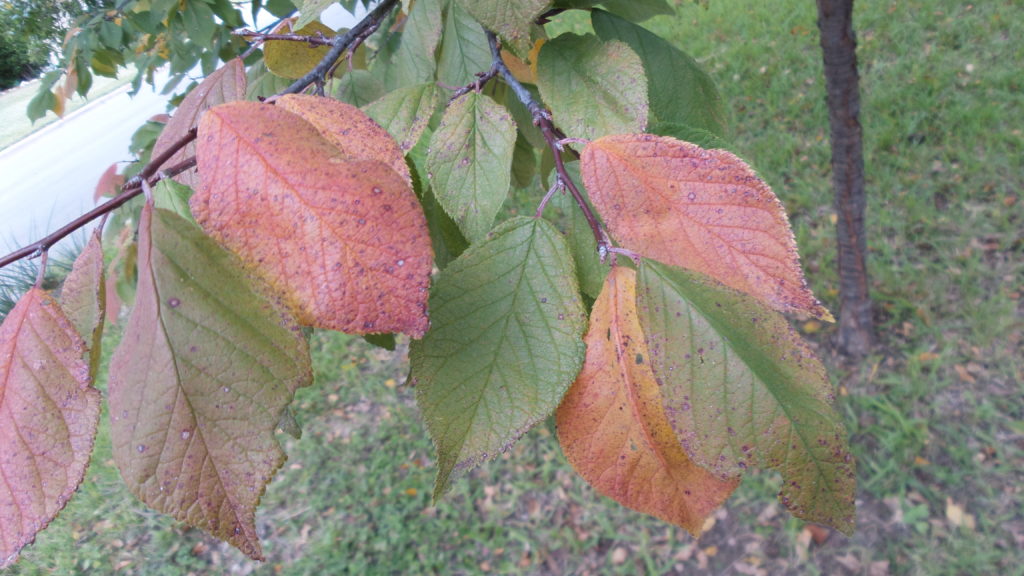Fall often seems like a fleeting memory, sometimes ebbing and flowing with temperature fluctuations typical of the Upper Gulf Coast Bend. Around October I look to nature for clues to seasonal changes so that I can fully embrace a natural rhythm and seasonal cycle. You may notice a patina and full on copper color of feathery Bald cypress (Taxodium distichum) leaves, a stately deciduous conifer occurring streamside in nature but also planted for its drought tolerance in the urban landscape. Perhaps you are anxiously waiting for production of bright red leaves on Shumard oak (Quercus shumardii), a native shade tree that can be grown successfully in the urban landscape. Below is a short list of native trees that we can use as an ornamental in the landscape as a means to bring fall color to our home:
Mexican plum (Prunus mexicana) is a small stature tree that can produce a broad canopy, growing to an estimated 25-feet. The elliptical-shaped leaves are slightly coarse to the touch and distinctively curl as they mature. Cooler weather initiates a rusty to yellow leaf color, a slightly different shade that adds to our fall color palette. This member of the Rose Plant Family (Rosaceae) offers pure white, open-faced flowers prior to leaf emergence in late winter. The flowers are very fragrant, are produced in clusters on branches and are a great seasonal resource to pollinators. After pollination, small rounded plum fruits are produced that ripen at summer’s end.
American hornbeam (Carpinus caroliniana) is a medium-sized tree, slow growing to 30-feet. Also commonly referred to as Musclewood, the bark is smooth and bluish-gray and slightly fluted to give the trunk a muscular appearance. The leaves are 2 to 3-inches long with prominent veins on the upper blade surface and a pointed leaf tip. A full canopy of small leaves offers great fall contrast with a profusion of gold yellow and rusty red. The tree can be placed in the understory of larger trees, and will adapt to full sunlight. They can tolerate periodic flooding and are naturally found in shaded woods, along riverbanks and in bottomland.
Red maple (Acer rubrum) is a fast growing native shade tree that has the potential to reach 60 feet tall in the home landscape, producing a narrow, rounded crown and smooth trunk. Autumn elicits a vibrant shade of red to orange-yellow from the leaves, making this a potential candidate to add color to our landscapes. They also provide pinkish-red flowers in late winter before leaves fully emerge, followed by distinctive winged seedpods (samaras) in early spring.
Shumard’s oak is a large tree and has the potential to reach 70-feet and taller in the home landscape. This species offers a wide canopy at maturity making it a potential selection as a shade tree. The leaves are simple 6 to 8-inch long with bristle-tipped lobes and deep sinuses, a shape typical of most oaks lumped in with red oak species. An interesting leaf characteristic are small pubescent tufts presented on the underside of the leaves and located where the veins connect. As mentioned earlier, Shumard oak does not disappoint with a display of bright red leaves offered in our fall season.
I always look to plants for seasonal cues, bringing a subtle nudge to acknowledge natural rhythms and my connection to nature. I encourage you to celebrate this fall season by finding your favorite hiking trail in a natural area or public park and observing the subtle and brilliant changes, gaining ideas to increase your plant palette and bringing a bit of nature home. Seasons greetings to you and your family, and I look forward to serving you in the near future with outstanding horticulture programs, and I’ll see you in the garden.

